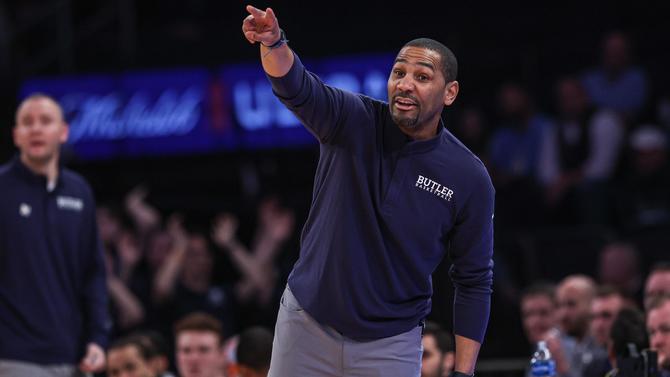College basketball programs turning to general managers: Inside the money moves from new-age front offices
Written by CBS SPORTS ALL RIGHTS RESERVED on August 27, 2024
Alabama football handed general manager Courtney Morgan a multi-year contract last week worth $825,000 annually in a milestone moment for college athletics. With the transfer portal here to stay and a salary cap likely on its way after the buzzy House settlement agreement, general managers can help navigate those choppy waters for programs.
It’s happening in college basketball, too. Fully-staffed front offices are coming to programs and for some, it’s already started.
Duke may have been the first to put a name on it when it hired long-time Nike executive Rachel Baker as its general manager just over two years ago.
Fast-forward to now, and numerous teams have followed suit and acquired general managers. Butler hired Tony Bollier from the Milwaukee Bucks in early July to be its new general manager/director of player development. Bollier was the general manager for the Bucks’ G League team, the Wisconsin Herd, for two seasons. Now, he’s stepping into a brand new position for Thad Matta.
New Charleston coach Chris Mack hired former Louisville captain and starting point guard Christen Cunningham as an assistant coach and general manager.
New Wyoming coach Sundance Wicks tabbed Patrick Stacy last week to be the Cowboys’ GM. Stacy founded Jam Basketball Intelligence, a company that curated scouting reports for numerous teams, including Wisconsin-Green Bay where Wicks coached this past season. Wicks revived arguably the worst program in college basketball, and Stacy’s scouting reports helped with that. They’ll team up again, this time in the Mountain West.
Syracuse snagged New York Knicks scout Alex Kline in late June to be the program’s general manager. Kline, long respected as a talent evaluator, is expected to help Syracuse allocate its resources with its NIL budget to build a contender. But he’s also in the process of building out Syracuse’s front office with sharp data whizzes like student manager Eugene Tulyagijja who built an app for Syracuse staffers loaded with scouting reports on potential additions, according to a Syracuse.com podcast with long-time beat writer Mike Waters.
Building a winner is the end goal for everybody, but for some, it might look like the Oakland A’s version of Moneyball.
Which players to target is valuable. How much to pay them will loom large in the salary cap era.
There are values to be had in the transfer portal, and general managers can help uncover them with data-based analysis, an eye for scheme-based fits and on-point, behind-the-scenes intel. Dalton Knecht, the reigning All-American, was not Tennessee’s highest-paid player. Marcus Domask didn’t cost a fortune for Illinois in the transfer portal last summer, but the Southern Illinois transfer turned into one of the best value gets in the cycle after he put together an All-Big Ten campaign.
Finding those diamonds in the rough can take a program to a new level. Vice versa, blowing too much of the NIL budget on ill-fitting players can have long-term ramifications. Some teams who pounced early in the big man market this past cycle landed productive frontcourt pieces and still had room for other big-money additions. Others who waited were either priced out or needed to dip into extra NIL coffers to meet the payday.
Of course, there are staffers throughout the country who don’t have the title of general manager (yet) who have been doing these sorts of projects already. Iowa just elevated Al Seibert to GM, but Seibert had been on Fran McCaffery’s staff for well over a decade. New Kentucky coach Mark Pope hired Mark Fox as his associate head coach. Fox, the former Nevada, California and Georgia coach, spent last season working as the director of student-athlete relations and NIL partnerships at Georgetown. Fox might not have the GM tag next to his name at Kentucky, but make no mistake, he’s expected to help Pope with more than just pick-and-roll defensive coverages.
Let’s dive into some of the top notable general managers in college basketball and the under-the-radar move that they helped put together in the 2024 transfer portal cycle.
Rachel Baker, Duke
Under-the-radar offseason move: Look at the usage rates of all the transfers Duke added this cycle.
- Syracuse’s Maliq Brown: 14%
- Tulane’s Sion James: 17%
- Purdue’s Mason Gillis: 13%
- Rice’s Cameron Sheffield (in 2022-23): 13%
Sensing a theme? Duke is going to give the ball to Tyrese Proctor, Caleb Foster, Cooper Flagg and Kon Knueppel. Duke filled out its roster with veterans who want to be low-usage, connect-the-dots, role players.
Oh, and defend. Brown is a multi-positional frontcourt defender who is super switchy and covers so much ground. Gillis is a stout wing defender who hits the glass with a vengeance. James is a ripply, 6-foot-6, 220-pound guard who can probably guard four, if not all five, positions. He’ll fly around with his hair on fire.
Duke’s portal additions combined with Flagg, Proctor and mammoth, 7-2 freshman Khaman Maluach give Jon Scheyer the personnel to build college basketball’s best defense.
Doug Stewart, BYU
Under-the-radar offseason move: Keba Keita looks like a steal and an immediate-impact contributor for BYU’s frontcourt. The 6-8, 230-pound, Utah transfer provides serious athletic pop to a team that needed it. Keita is armed with a huge wingspan and incredible vertical bounce. He’s the perfect complement to Fousseyni Traore who is more of a below-the-rim banger. They’ll form a tag-team, big-man platoon, but BYU’s rim defense should be way better when Keita is on the floor. Opponents shot just 52% at the rim last year against Utah when Keita was in the game.
Baker Dunleavy, Villanova
Under-the-radar offseason move: Penn transfer Tyler Perkins looks like a hit, but it might take a minute for that to fully coalesce with Wooga Poplar, Eric Dixon and Jhamir Brickus running the show. But Villanova’s roster is pretty top-heavy. Dixon, Brickus, Poplar and Jordan Longino will all be out of eligibility after the season, and Perkins should be a huge part of the solution long-term. He may be Villanova’s sixth man in 2024-25 who can provide both floor-spacing and bootyball, but Perkins can transform into an alpha in 2025-26.

LaVall Jordan, DePaul
Under-the-radar offseason move: Jordan, the former Butler head coach, will wear multiple hats for DePaul under new head coach Chris Holtmann. Jordan will be the general manager while serving as one of Holtmann’s trusted assistant coaches. Their fingertips are all over this DePaul roster construction. DePaul loaded up on shooting galore in its built-from-scratch backcourt. Jacob Meyer, Isaiah Rivera, David Thomas, Troy D’Amico, CJ Gunn and Conor Enright all shot over 34% from 3-point range last season. All that shooting should maximize the one non-shooter in DePaul’s backcourt who has the highest ceiling of anybody on the team: Layden Blocker. The Arkansas transfer has a supporting cast that can cover up his flaws and maximize his strengths. The drive-first point guard should have so much space to get downhill, especially when big man David Skogans (a 46% 3-point shooter) is dragging big men out of the paint.
This looks like smart roster-building on paper by Holtmann’s brain trust, but it’s a big bet on Blocker finding his way.
Kyle Church, Michigan
Under-the-radar offseason move: Kyle Church is doing double duty for Michigan. He maintained his assistant coach duties while doubling as Michigan’s general manager. The longtime Dusty May confidant has helped the Wolverines build a roster that can be a Big Ten contender both right now and have some staying power. Four of the six transfers that Michigan reeled in this offseason have multiple years of eligibility remaining. Auburn transfer Tre Donaldson has the runway to be a multi-year stud for Michigan. So does Ohio State transfer Roddy Gayle Jr. and Yale transfer big man Danny Wolf. Alabama transfer Sam Walters also has three years of eligibility remaining. Michigan could have five of its top seven players run it back in 2025-26 for Year 2 of the May era.
READ MORE: Inside the explosion of Year 2 transfers
Chris Woolard, Arkansas
Under-the-radar offseason move: John Calipari brought Woolard, a long-time Kentucky staffer, over to Arkansas and named him general manager. They built a talent-laden frontcourt that features very little positional overlap. That’s a good thing.
Jonas Aidoo is the closest thing to a back-to-the-basket big man, but he’s an excellent escape valve for Arkansas’ guards in what is expected to be a heavy ball-screen offense. Aidoo isn’t much of a 3-point shooter yet, but he’s automatic in the in-between game. Zvonimir Ivisic has a ways to go defensively, but the passing and shooting provide Arkansas with a true five-out hub. Trevon Brazile hasn’t proven to be much of a playmaker, but he’s the best pure shooter in this frontcourt with real NBA range. Brazile can go get himself a bucket, and his rare combination of size and fluidity is tantalizing. Adou Thiero is still working with his jumper, but he’s a hellacious driver who brings so much force and oomph to both sides of the floor.
Calipari has options galore with this quartet.
Kellen Buffington, Texas Tech
Under-the-radar offseason move: Devan Cambridge nearly officially entered the transfer portal this spring, but he was quickly convinced by head coach Grant McCasland, general manager Kellen Buffington and the rest of the Texas Tech staff to stay in Lubbock. There weren’t many sturdy, multi-positional, defense-first forwards who could also stretch the floor in the portal. That coveted skillset made the free agents expensive.
Texas Tech didn’t have to dip its toes into those waters because it was able to retain Cambridge. He’s on the mend after a devastating, season-ending knee injury, but when healthy, he’s a perfect complement for Texas Tech’s prized additions. He gives new point guard Elijah Hawkins a bouncy lob threat. He also provides another thumper who can handle more of the Big 12’s big wings so prized forward JT Toppin can swarm the paint instead of getting too spread thin on the perimeter. McCasland has so many lineup options with Cambridge in the mix. He can go big with Cambridge at the 3 or small with the Toppin-and-Cambridge duo sopping up the frontcourt minutes.
Jason Smith, Baylor
Under-the-radar offseason move: Baylor ponied up the big bucks for Duke’s stud guard Jeremy Roach and Miami’s uber-productive, small-ball big man Norchad Omier in the portal, but the third and far less buzzy portal addition checked off so many boxes, too. Baylor desperately needed more size on the perimeter. It certainly needed another shooter to surround its cavalry of guards. It found both in Jalen Celestine. The 6-foot-7, Cal transfer splashed 47% of his catch-and-shoot treys last year. Maybe most importantly, Celestine is a role player who wants to be part of the supporting cast.
Baylor won’t have to take away any touches from prized freshman VJ Edgecombe or Roach to keep Celestine happy. He had the best season of his career with a 13% usage rate last year at Cal playing off first-round pick Jaylon Tyson. Less should be more for both Baylor and Celestine. This has the makings of a sharp addition for Scott Drew and general manager Jason Smith.
The post College basketball programs turning to general managers: Inside the money moves from new-age front offices first appeared on OKC Sports Radio.





